The freshness of the air suggests that clouds may soon unleash some rain. The water of the creek flows by undisturbed breaking up into ripples whenever a canoe goes by. Looking out onto the savannah a sense of calmness envelops one; this is the feeling of serenity conferred by Wakapoa.
Wakapoa is an Amerindian community in Region 2 which is located about 35 miles by river from Charity, the nearest commercial district. To get there, one must travel by speedboat from Charity down the Pomeroon River where it flows parallel to the coast. Other boats frequently zip past since this is the main form of transportation in the area.
When it seems that you are bound to reach the Atlantic Ocean, the boat suddenly turns off into a narrow clearing between the trees. This is the beginning of the Wakapoa Creek where the trees bend to form an overhead archin welcome and mangrove roots plunge down and secure themselves in the river bed.
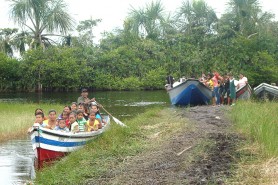
As you make your way along, the boat skimming the suface as it adjusts to the bends in the creek, the trees give way to open savannah-type vegatation. About nine miles along the creek, the sight of buildings indicates that Wakapoa beckons. A huge silk-cottonwood tree serves to mark the threshold of the settlement.
The community is in fact made up of a number of islands on which the residents are dispersed.

“Wakapoa is very hard,” said Lorraine Richards as she walked along the path leading to the playground in Massarie, one of the settlements. Residents were coming out for the launch of a new cellular site in their area. Much later it became apparent that there was not much to do, so when anything was happening the villagers came out.
Richards was referring to the
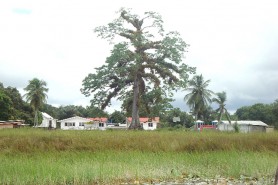
lack of employment opportunities in the community. “Most youths are not working. They idling – well, because they have no jobs,” Richards said. Since there is no industry in the community, some of the residents engage in logging, travel to the interior to work the goldmines or are teachers.
However, the majority of the three thousand residents are farmers who produce cassava, plantain, eddoes and coconuts to sell in the markets at Pomeroon and Charity. However some felt that much more could be done to provide greater marketing avenues for farmers. “Depending on the time of year, the price doesn’t be good,” said Earl Thomas.
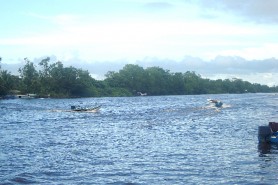
“Wakapoa Gold” – the label once associated with the community’s vibrant coffee industry is expected to be restarted next year. Toshao Lloyd Perreira said that residents were being encouraged to return to coffee production which could provide an income for them since there was an available market for the product.
At St Lucia, the nursery, primary and secondary schools can be found. At Korria, another settlement, there is a primary school while at Mora (Upper Wakapoa) there is a nursery and a primary school.
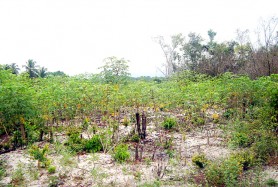
Although there are school buildings, residents said that there was need for more teachers at the primary and secondary levels. “Education is not to the level it should be,” said Earl; “at the secondary school they are only doing four subjects at CSEC – that’s not good enough.” While there are several volunteers based in the community, his view was that when these come to the community, they had to adjust to a different way of life which took time.
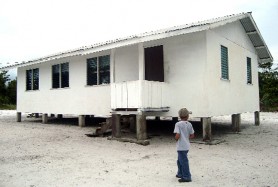
There is a health centre at St Lucia but it does not have its full complement of staff. At present there are two community health workers and a nurse attending to the needs of residents. “Medication is a problem; you have to buy your own drugs at Charity,” said another resident. Expectant mothers are referred to the Suddie Hospital located on the Essequibo Coast.
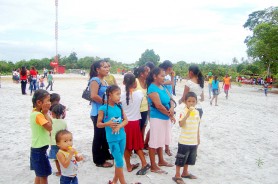
The recent opening of a solar powered cellular site by Digicel was expected to boost telecommunications within the community. Previously, residents would have to adopt all manner of precarious positions to be able to make a phone call. While there is no electricity supply in the area, some residents have opted to buy solar panels which are becoming increasingly popular. Water is sourced from the creek or collected when it rains.
There are no entertainment spots so the young men occupy themselves in various sports. Girls help out at home and do whatever they can to pass time. “It gets very boring sometimes since there is not much to do,” said one young lady.
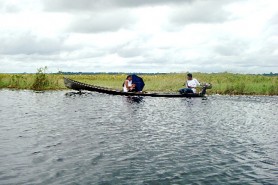
Three Amerindian tribes – Caribs, Warraus and Arawaks – call this place home. However, the younger generation does not know the Arawak language; it is mainly spoken by the elders. “They think that halekuba (a greeting for hi, hello) is something to eat,” said Thomas. “Most have drifted away from our culture – only a handful involved in craft, music and dance.”
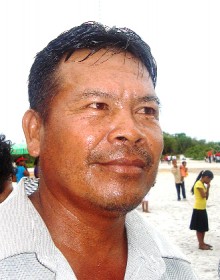
“Some parts are dying while some maintained. Farming is a part of culture so we do that,” a resident commented. However tibisiri and cotton-spinning are lost art forms.
“All the people are nice”; “It’s quiet here but a nice place to live” are just two of the ways residents described Wakapoa.
A light drizzle starts, but then the sun appears; with the threat of rain gone, there will be a game of cricket.








